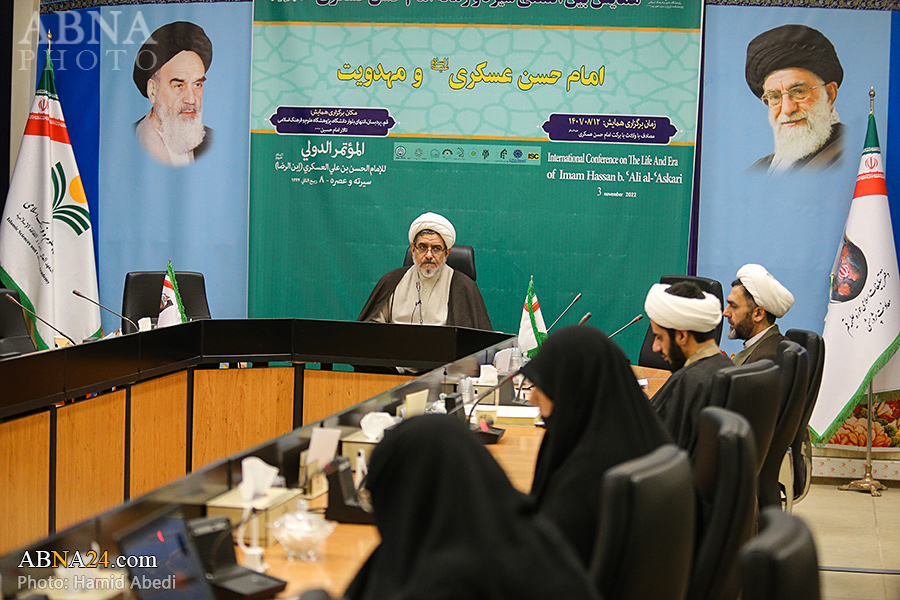The session of the commission “Imam Hassan Askari (a.s.) and Mahdaviat”, under the international conference “Tradition and Era of Imam Hassan Askari (a.s.)”, was held on Thursday morning, November 3, 2022, in the Imam Hussain (a.s.) Hall of the Islamic Sciences and Culture Academy in Pardisan, Qom.

The Board of Directors of this commission was composed of Messrs. Hossein Elahi Nejad, Sayed Monzer Hakim and Dr. Majid Ahmadi Kachai.
At the beginning of the session, while offering congratulations on the occasion of the birth anniversary of Imam Hassan Askari, Dr. Elahi Nejad, announced that 7 issues will be presented and discussed in the commission.
In presenting the article “Role of Imam Hassan Askari (a.s.) in the preparation of the Shiite community for the era of Occultation”, Hojat al-Islam Ali Asghar Sanai stated, “The article seeks to answer the question of what was the role of Imam Hassan Askari (a.s.) in preparing the Shiite community for the age of Occultation (of Imam Mahdi (a.s.).)”
“Since the time of Imam Reza (a.s.) the subject of Occultation had a special importance. Throughout history, until the time of Imam Hassan Askari (a.s.), some people appeared with the claim of Mahdaviat, which implies the knowledge about Mahdaviat at that time,” he added.
“In order to prepare the society to enter the Age of Occultation, Imam (a.s.) used to take negative measures. For example, due to the sensitivities of the Mahdaviat issue, he started a fight with deviant sects such as Waghefiyyah, Mufawezah, and Sufism and declared it forbidden to pray behind them. It was while the Imam (a.s.) considered it permissible to pray behind the Sunnis (participating in their congregational prayers),” the researcher stated.
“Before Imam Hassan Askari (a.s.), the Shiite public opinion was familiar with Mahdaviat, and as the time of that Imam approached, Shiites followed the issue more seriously,” Hojat al-Islam Sanai said in another part of his presentation.
“One of the actions of the 11th Imam is to strengthen the network of representatives or deputies. In the Age of Occultation, the Imam’s connection with the people was supposed to be cut off. Therefore, Imam took the issue into consideration. Although Imam Hassan Askari (a.s.) had the authority to receive Sharia Payments directly, he referred the clients to his representatives. For example, people from Yemen came to Imam (a.s.) to pay Sharia Payments, but he sent them to his representative Uthman bin Said,” he added.
“The next action of Imam (a.s.) was to cultivate public opinion for the Mahdaviat issue. Information about the birth of Imam Mahdi (a.s.) was confidential at first, and Imam Hassan Askari (a.s.) first announced the birth of his son to the first circle of his companions and then widened the circle. The 11th Imam acted in the same way in introducing the character of Imam Mahdi (a.s.) and presented the character of his son in stages. Then, he discussed the issue of succession and finally the discussion of his son’s long occultation,” the history researcher said.
Further in the session, in presenting the article “Measures of Imam Askari (a.s.) in defending Imam Mahdi (a.s.) against the threat”, Hojat al-Islam Majid Ahmadi Kachai stated, “Imam Hassan Askari (a.s.) was responsible for guiding the Shiites and protecting the life of Imam Mahdi (a.s.). Imam Mahdi (a.s.) was the only Infallible (of 14 Infallibles) that some people wanted to kill since his birth. Imam Hassan Askari (a.s.) knew that if he introduced his son, he would be killed. Imam (a.s.) knows that to save his son’s life, he had to hide him, and in this absence, some people may go astray, but there was no other option.”
“With the beginning of the Minor Occultation period of Imam Mahdi (a.s.), everyone believed in his Imamate,” he said in another part of his presentation.
“According to Kulayni and Masoudi, two months before his martyrdom, Imam Hassan Askari (a.s.) sent Imam Mahdi (a.s.) and his mother to Hajj. According to the same narration, we do not accept the presence of Imam Mahdi (a.s.) in the funeral prayer of his father, Imam Hassan Askari (a.s.). Because there are other narrations that Imam Mahdi (a.s.) did not attend his father’s funeral prayer, and this narration does not contradict any of the Shiite beliefs,” said the Assistant Professor at the Islamic Sciences and Culture Academy.
“Uthman bin Saeed was asked the name of Imam Mahdi (a.s.). In response, Uthman demanded people not to ask him about this because “we have taken measures so that Abbasids will not notice the Imam’s presence”. It is worth mentioning that at that time, the security situation was so tense that until about 20 years after the birth of Imam Mahdi (a.s.), Al-Mu'tadid Abbasid caliph was looking for that Imam (a.s.),” added this professor in another part of his presentation.
After the presentation of Prof. Kachaei’s article, Mrs. Leila Sharifi presented the article “Measures of Imam Hassan Askari (a.s.) to save his son’s life”.
In her presentation, Sharifi said, “According to the authentic narrations about Mahdaviat, the Abbasid rulers considered the presence of Imam Mahdi (a.s.) as a danger for their dynasty. Also, considering the difficult conditions of Imam Hassan Askari (a.s.) and his imprisonment, it is natural for him to take measures to save the life of his son Imam Mahdi (a.s.). These measures include: 1. Hiding the pregnancy of Narjis (a.s.), the mother of Imam Mahdi (a.s.) as a secret, in such a way that even the Imam’s (paternal) aunt did not know about it; 2. Hiding the child’s birth a secret so that the Imam Hassan (a.s.) did not inform anyone about the birth of his son and only his sister and servants were present at the time of birth; 3. Imam Hassan Askari (a.s.) entrusted his son’s Aqiqa (sacrificing sheep for a new-born baby) to his companions so that he would not do it himself; 4. Imam Hassan Askari (a.s.) informed his special companions about the birth of Imam Mahdi (a.s.), to prevent them from perplexity and confusion after his own demise (martyrdom); 5. Introducing and showing Imam Mahdi (a.s.) to companions such as Ahmad ibn Ishaq Ash’ari Qomi; 6. Introducing his successor, without referring to the name and nickname, and only referring to the signs; 7. Changing the places of Imam Mahdi (a.s.) at different times; 8. Imam Hassan Askari (a.s.) went to the court of the Abbasid caliphs reluctantly, to hide Imam Mahdi (a.s.); 9. Banning the use of the name of Imam Mahdi (a.s.) and the use of other names such as “Saheb” (Owner) or “Nahie Moqadase” (Sacred Area); 10. Appointing the mother as the successor and mentioning the child’s name in the will.”
The last article that was presented in this session was the article “The role of two Askari Imam (a.s.) (the 10th and 11th Imams) in preparing the society to accept the Occultation of Imam Mahdi (a.s.)” by Mrs. Fatima Mohammadi.
“Since Occultation was a peculiar issue at that time, the Shiites might have been perplexed. Therefore, the two Askari Imams (a.s.) spoke about Mahdaviat. Even from the time of the Prophet (p.b.u.h), Mahdaviat was discussed,” Mrs. Mohammadi said.
“One of the political activities of the two Askari Imams (a.s.) was that they had infiltrated some of their agents in the Abbasid Caliphate system. Sometimes the government finds out about their existence, and the Imams using their knowledge, inform their agents about this exposure. The two Askari Imams (a.s.) also engaged in economic activities so that they could use its resources when necessary. Also, these two Imams made great efforts to prepare the society for Occultation,” she added.
It should be noted that the international conference “Tradition and Era of Imam Hasan Askari (a.s.)” was held by Islamic Sciences and Culture Academy in cooperation with AhlulBayt (a.s.) World Assembly, Imam Khomeini Education and Research Institute, Research Institute of Hawzeh and University, Baqir al-Olum (a.s.) University, Al-Zahra (a.s.) University of Seminary, Al-Zahra (a.s.) University of Qom, Research Institute of Hajj and Pilgrimage, University of Religions and Denominations, and University of Isfahan.
Source: Abna24

